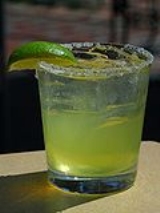
Margarita
Encyclopedia
The margarita is a cocktail
consisting of tequila
mixed with orange
-flavoured liqueur
and lime or lemon
juice
, often served with salt
on the glass
rim. It is the most common tequila-based cocktail in the United States
. The drink is served shaken with ice, on the rocks, blended with ice (frozen margarita) or without ice (straight up).
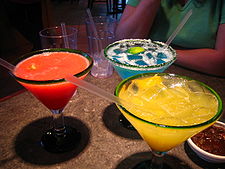 The IBA
The IBA
(IBA Official list of Cocktails
) standard is
7:4:3, that is, 50% tequila, 29% Cointreau
, 21% fresh lime or lemon juice.
, blue curaçao
yielding the blue margarita. When sweeter fruit juices or freshly puréed fruits are added to the margarita, the amount of orange-flavored liqueur is often reduced or eliminated entirely. In addition to orange-flavored liqueurs, secondary liqueurs may occasionally be added to the cocktail, including melon-flavored or black raspberry-flavored.
. However, margaritas in Mexico are generally made with Mexican limes (Key limes). These are small, thin skinned limes and have a more tart and an often bitter flavor compared to Persian limes. Margaritas made with lemon have a softer taste, especially when Meyer lemon
s are used.
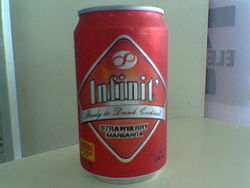

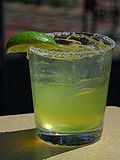
Another common story related the Margarita being invented a few years earlier at the Rancho La Gloria Hotel, halfway between Tijuana and Rosarito, Mexico, by Carlos "Danny" Herrera, for a former Ziegfeld
dancer named Marjorie King. This story was related by Herrera and also by bartender Albert Hernandez, who is acknowledged for popularizing the Margarita in San Diego after 1947, at the La Plaza restaurant in La Jolla. Hernandez claimed the owner of La Plaza, Morris Locke, knew Herrera and visited Mexico often.
Another common origin tale begins the cocktail’s history at the legendary Balinese Room
in Galveston, Texas where, in 1948, head bartender Santos Cruz created the Margarita for singer Peggy Lee
. He supposedly named it after the Spanish version of her name, Margarita, and it’s been a hit ever since.
The most plausible explanation, however, is that the Margarita is merely a popular American drink, the Daisy
, remade with tequila instead of brandy, which became popular during Prohibition
as people drifted over the border for alcohol. There is an account from 1936 of Iowa newspaper editor James Graham finding such a cocktail in Tijuana, years before any of the other Margarita "creation myths". Margarita is Spanish for Daisy. It is likely that Orozco and Herrara merely perfected the "Tequila Daisy".
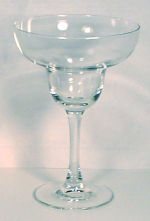 Margaritas may be served in a variety of glasses, most notably the stereotypical margarita glass, a variant of the classic Champagne coupe; this is particularly associated with blended fruit margaritas, and the glass is also used for dishes such as guacamole
Margaritas may be served in a variety of glasses, most notably the stereotypical margarita glass, a variant of the classic Champagne coupe; this is particularly associated with blended fruit margaritas, and the glass is also used for dishes such as guacamole
or shrimp cocktails. In formal settings margaritas are often served in a standard cocktail glass
, while in informal settings, particularly with ice, margaritas may be served in an old-fashioned glass.
Cocktail
A cocktail is an alcoholic mixed drink that contains two or more ingredients—at least one of the ingredients must be a spirit.Cocktails were originally a mixture of spirits, sugar, water, and bitters. The word has come to mean almost any mixed drink that contains alcohol...
consisting of tequila
Tequila
Tequila is a spirit made from the blue agave plant, primarily in the area surrounding the city of Tequila, northwest of Guadalajara, and in the highlands of the western Mexican state of Jalisco....
mixed with orange
Orange (fruit)
An orange—specifically, the sweet orange—is the citrus Citrus × sinensis and its fruit. It is the most commonly grown tree fruit in the world....
-flavoured liqueur
Liqueur
A liqueur is an alcoholic beverage that has been flavored with fruit, herbs, nuts, spices, flowers, or cream and bottled with added sugar. Liqueurs are typically quite sweet; they are usually not aged for long but may have resting periods during their production to allow flavors to marry.The...
and lime or lemon
Lemon juice
The lemon fruit, from a citrus plant, provides a useful liquid when squeezed. Lemon juice, either in natural strength or concentrated, is sold as a bottled product, usually with the addition of preservatives and a small amount of lemon oil.-Uses:...
juice
Juice
Juice is the liquid that is naturally contained in fruit or vegetable tissue.Juice is prepared by mechanically squeezing or macerating fruit or vegetable flesh without the application of heat or solvents. For example, orange juice is the liquid extract of the fruit of the orange tree...
, often served with salt
Salt
In chemistry, salts are ionic compounds that result from the neutralization reaction of an acid and a base. They are composed of cations and anions so that the product is electrically neutral...
on the glass
Glass
Glass is an amorphous solid material. Glasses are typically brittle and optically transparent.The most familiar type of glass, used for centuries in windows and drinking vessels, is soda-lime glass, composed of about 75% silica plus Na2O, CaO, and several minor additives...
rim. It is the most common tequila-based cocktail in the United States
United States
The United States of America is a federal constitutional republic comprising fifty states and a federal district...
. The drink is served shaken with ice, on the rocks, blended with ice (frozen margarita) or without ice (straight up).
Variations

International Bartenders Association
The International Bartenders Association, often confused with the International Bar Association, founded on February 24, 1951 in the Saloon of the Grand Hotel in Torquay, England, is an international organization established in order to represent the best bartenders in the world.An annual event,...
(IBA Official list of Cocktails
IBA Official Cocktail
An IBA Official Cocktail is one of many cocktails selected by the International Bartenders Association for use in the annual World Cocktail Competition in bartending...
) standard is
7:4:3, that is, 50% tequila, 29% Cointreau
Cointreau
Cointreau is a brand of triple sec produced in Saint-Barthélemy-d'Anjou, France. It is drunk as an apéritif and digestif, and is a component of several well-known cocktails. It was originally called "Curaçao Blanco Triple Sec".-Production:...
, 21% fresh lime or lemon juice.
Flavored liqueurs
Orange-flavored liqueurs that might be used include triple secTriple sec
Triple sec, originally Curaçao triple sec, is a variety of Curaçao liqueur, an orange-flavoured liqueur made from the dried peels of bitter and sweet orange....
, blue curaçao
Curaçao liqueur
Curaçao is a liqueur flavoured with the dried peel of the laraha citrus fruit, grown on the island of Curaçao. A non-native plant similar to an orange, the laraha developed from the sweet Valencia orange transplanted by Spanish explorers. The nutrient-poor soil and arid climate of Curaçao proved...
yielding the blue margarita. When sweeter fruit juices or freshly puréed fruits are added to the margarita, the amount of orange-flavored liqueur is often reduced or eliminated entirely. In addition to orange-flavored liqueurs, secondary liqueurs may occasionally be added to the cocktail, including melon-flavored or black raspberry-flavored.
Fresh lime juice
Freshly squeezed lime juice is the key ingredient. The most common lime in the U.S. is the thick skinned Persian limePersian lime
Persian lime , also known as Tahiti lime or Bearss lime , is a citrus fruit sold simply as a "lime" in the United States...
. However, margaritas in Mexico are generally made with Mexican limes (Key limes). These are small, thin skinned limes and have a more tart and an often bitter flavor compared to Persian limes. Margaritas made with lemon have a softer taste, especially when Meyer lemon
Meyer lemon
Citrus × meyeri, the Meyer lemon, is a citrus fruit native to China thought to be a cross between a true lemon and either a mandarin or common orange. It was introduced to the United States in 1908 as S.P.I...
s are used.
Other fruits
Alternate fruits and juice mixtures can also be used in a margarita. Many recipes call for a splash of orange juice. When the word "margarita" is used by itself, it typically refers to the lime or lemon juice margarita, but when other juices are used, the fruits are typically added as adjectives in the name; with lime juice or lemon juice added to give it a characteristic margarita flavor (a wedge of lime is often added to the glass).History



Origin
There is no solid proof who "invented" the Margarita. The most accepted of all stories is that the Margarita was invented in October 1941, at Hussong's Cantina in Ensenada, Mexico, by bartender Don Carlos Orozco. One slow afternoon, Don Carlos was experimenting with mixing new drinks when a prestigious visitor arrived: Margarita Henkel, the daughter of a German ambassador, who lived with her husband Roy Parodi near the city in Rancho Hamilton. Don Carlos offered the drink to Margarita, and named it after her for being the first person to taste it. He concocted a mixture of equal parts tequila, orange liqueur and lime, served over ice in a salt-rimmed glass.Another common story related the Margarita being invented a few years earlier at the Rancho La Gloria Hotel, halfway between Tijuana and Rosarito, Mexico, by Carlos "Danny" Herrera, for a former Ziegfeld
Ziegfeld Follies
The Ziegfeld Follies were a series of elaborate theatrical productions on Broadway in New York City from 1907 through 1931. They became a radio program in 1932 and 1936 as The Ziegfeld Follies of the Air....
dancer named Marjorie King. This story was related by Herrera and also by bartender Albert Hernandez, who is acknowledged for popularizing the Margarita in San Diego after 1947, at the La Plaza restaurant in La Jolla. Hernandez claimed the owner of La Plaza, Morris Locke, knew Herrera and visited Mexico often.
Another common origin tale begins the cocktail’s history at the legendary Balinese Room
Balinese Room
The Balinese Room was a well-known nightclub in Galveston, Texas, United States built on a pier stretching 600 feet from the Galveston Seawall over the waters of the Gulf of Mexico...
in Galveston, Texas where, in 1948, head bartender Santos Cruz created the Margarita for singer Peggy Lee
Peggy Lee
Peggy Lee was an American jazz and popular music singer, songwriter, composer, and actress in a career spanning six decades. From her beginning as a vocalist on local radio to singing with Benny Goodman's big band, she forged a sophisticated persona, evolving into a multi-faceted artist and...
. He supposedly named it after the Spanish version of her name, Margarita, and it’s been a hit ever since.
The most plausible explanation, however, is that the Margarita is merely a popular American drink, the Daisy
Brandy Daisy
The Brandy Daisy is a cocktail which first gained popularity in the late 19th century. One of the earliest known recipes was published in 1876 in the second edition of Jerry Thomas's The Bartenders Guide or How To Mix Drinks: The Bon-Vivants Companion:...
, remade with tequila instead of brandy, which became popular during Prohibition
Prohibition in the United States
Prohibition in the United States was a national ban on the sale, manufacture, and transportation of alcohol, in place from 1920 to 1933. The ban was mandated by the Eighteenth Amendment to the Constitution, and the Volstead Act set down the rules for enforcing the ban, as well as defining which...
as people drifted over the border for alcohol. There is an account from 1936 of Iowa newspaper editor James Graham finding such a cocktail in Tijuana, years before any of the other Margarita "creation myths". Margarita is Spanish for Daisy. It is likely that Orozco and Herrara merely perfected the "Tequila Daisy".
Glass

Guacamole
Guacamole , is an avocado-based dip that originated in Mexico. It is traditionally made by mashing ripe avocados with a molcajete with sea salt. Some recipes call for limited tomato, spicy Asian spices such as white onion, lime juice, and/or additional seasonings.-History:Guacamole was made by...
or shrimp cocktails. In formal settings margaritas are often served in a standard cocktail glass
Cocktail glass
A cocktail glass is a stemmed glass which has a cone-shaped bowl placed upon a stem above a flat base. It is mainly used to serve cocktails. Its form derives from the fact that all cocktails are traditionally served chilled and contain an aromatic element...
, while in informal settings, particularly with ice, margaritas may be served in an old-fashioned glass.
Popularity
The margarita cocktail was the "Drink of the Month" in Esquire magazine, December 1953, pg. 76:- 1 ounce tequila
- Dash of Triple Sec
- Juice of 1/2 lime or lemon
- Pour over crushed ice, stir. Rub the rim of a stem glass with rind of lemon or lime, spin in salt—pour, and sip.

